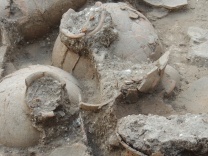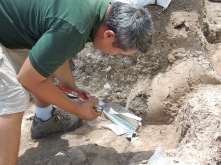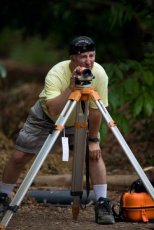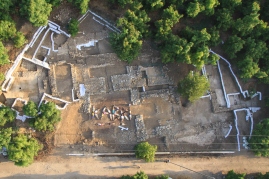Update, 20 July: The 2015 season has now concluded. For the preliminary report on the results of the 2015 season, please click on the following link:
Preliminary Report on the Results of the 2015 Excavation Season at Tel Kabri final version
(NB: The following is no longer applicable, but may still be of interest to those contemplating participating in our next season, during the summer of 2017.)
Come dig with us at Tel Kabri this coming summer! When else will you have the opportunity to excavate in a Canaanite palace more than 3,500 years old, decorated with Minoan-style floor and wall paintings?
(video by Sarah Cahlan; courtesy of National Geographic)
Located in a quiet rural setting within the western Galilee of Israel, only a ten minute ride from the historical town of Acco, with its Medieval and Ottoman old city, fishing harbor and traditional market, and the modern resort town of Nahariya, the site of Tel Kabri has what may be the earliest-known Western art yet found in the Eastern Mediterranean. Today the Tel and its surroundings are an agricultural land, with lush plantations of bananas and avocados overlying the ancient remains.
Kabri represents one of the only possible opportunities available today in the Eastern Mediterranean to test some of the anthropological theories about the rise of archaic states and the nature of various political economies in the Aegean and the Near East. The readily available palace and settlement, with minimal overburden and with rather limited previous excavations, enables the use of modern methods such as residue analysis, petrographic analysis, detailed zooarchaeological study, neutron activation analysis, stable isotope analysis, and petrography to gain insights into some of the most important topics relevant to the understanding of complex human societies.
Previous Seasons
During excavations conducted at the site from 1986-1993 by the late Professor Aharon Kempinski and Professor Wolf-Dietrich Niemeier, a floor and wall frescoes painted in an Aegean manner—probably by Cycladic or Minoan artists—were discovered within a building that they identified as a palace.
Our preliminary excavations in 2005 indicated that the palace, which dates to the Middle Bronze (MB) IIB period during the early second millennium BCE, is at least twice as large as previously thought, with much still remaining to be excavated.
During the 2008 season of excavations we were able to retrieve data from the entire history of the MB palace, from a pre-palatial period through to final destruction. We also found approximately 45 more fragments of wall plaster, at least some of which appear to be painted, and additional evidence for red paint on one of the plaster floors in the palace.

Our 2009 season saw the continued excavation of the palace, with the goal of investigating its life cycle, from humble beginnings to its destruction three centuries later. We were successful in doing so, and in the process found approximately 100 additional pieces of wall and floor plaster, including 60 which were painted.
Our 2011 season yielded more painted fresco fragments and a large building adjacent to the palace, perhaps a temple. In this building, the rooms were lined with carved orthostat blocks still in place, so we are calling it the “Orthostat Building.”
And, in 2013, we found the oldest and largest wine cellar in the ancient Near East, in the storage rooms of the palace. We will be continuing the excavation of these during the 2015 season.
Upcoming Season
We’ll be digging for four weeks, from 14 June to 9 July 2015. The cost to you will be $750 per week ($600 for returnees and consortium members), in return for which you’ll have air-conditioned rooms, good food, and a beautiful beach just steps away (airfare and course credits are extra, plus you’ll need additional money for traveling on the weekends).
For those who work for a living and who cannot make it for the entire time, we’re happy to work with you and/or your group to make special arrangements (if we have room), so please contact us.











Hello,
Is there any way for a minor (under 18) to participate in this dig? Some form or liability waiver to sign?
Can the age be a negotiable point, such as one having a high school diploma and waver iin place of 18?
LikeLike
Usually only with a parent or a guardian accompanying. But, we have made exceptions. Send me an email (ehcline@gwu.edu) with more details and we’ll talk privately.
LikeLike
It was a fascinating presentation on the subject along with the collapse of civilization in 1177 bce last Saturday at the Jewish American University in LA. Thank you for a very well prepared symposium.
It was my first to attend such a symposium. You definitely got me very interested in Archaelogy! Hopefully, if not this year, I can join you in one of your digs! Is it okey for Seniors? I am still pretty lean, strong and agile. I had asked for a picture pose with you at the end of the meeting, if you can remember! — Manny
LikeLike
Hi Manny — Glad you liked the symposium! And yes, you’d be welcome on the dig!
LikeLike
I am very interested in volunteering for the summer of 2017. Is any information available on this excavation?
LikeLike
Yes. The website name is very similar to this one, but with 2017 instead of 2015: digkabri2017.wordpress.com … all of the information and the preliminary application can be found there.
LikeLike
I saw the comment “ongoing digs” somewhere… are you still digging at Tel Kabri?
LikeLike
Yes. Go to https://digkabri2019.wordpress.com .
LikeLiked by 1 person
Thanks!!
LikeLike